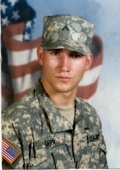The death of a soldier
07/05/12 05:56

His family has lived with the risk of his death for a long time. He served as an intelligence Sergeant of an armed reconnaissance squadron forward deployed in Iraq. Over 200 combat missions in the Ninewa Province of Iraq placed him at risk day after day. 4,486 US troops died in Iraq. His family breathed a sigh of relief when he came home.
It wasn’t along before he was once again facing danger, this time in Afghanistan. Again he participated in hundreds of combat missions. Again his family was deeply aware of the risk he faced daily. 1960 US soldiers have died in Afghanistan. When he returned to the United States in March they had a moment of feeling he was once again safe.
The news of his death came as a shock.
Official military records record fatalities and injuries from military service in war zones. In addition to the fatalities, over 45,000 service men and women have been severely injured. Nearly 20% of the injured have suffered traumatic brain injuries. Casualties have been highest among those serving in the Army. The price of these wars has been high.
The statistics, however, do not tell the entire story. Statistics count physical injuries. Officials can count the number of destroyed limbs, the number of soldiers returning with crutches and wheelchairs and artificial limbs. There is no way to obtain an official count of damage to mental health. It is widely accepted that the number of diagnoses of Post Traumatic Stress Disorder are far lower than the number of actual victims.
There are many different ways to die as a result of service in the military. Some risks are obvious and garner a lot of attention on the news. Others are not so obvious. Soldiers who die as the result of the effects of stress and of other mental illnesses are often not included in official casualty reports.
The families who have lost these victims, however, know the truth. The loss is every bit as real. The pain is every bit as devastating. The grief is every bit as overwhelming.
The cost of the wars has been higher than the statistics report.
One of the ways to learn about the community in which you live is to read obituaries. Every obituary is a biography of sorts. The stories of the people of our community are contained not only in the descriptions of lives lived in the obituaries, but also in the list of the names of the survivors. Reading the list of survivors and then reading the “preceded in death by” will give a catalogue of grief experienced by a family. Obituaries often carry truth both in what is said and in what is not said.
I suppose it is a product of my age, but I can’t help but looking at the age of the victims. There is grief associated with every death, but there is a unique grief that is attached to the loss of a child. Victims under the age of thirty almost always have a parent among the survivors. Saturday was a tough day for our community’s obituaries. There were a dozen obituaries. A third of them told the stories of someone who died before their thirtieth birthday.
The soldier who will be laid to rest in Black Hills National Cemetery was only 24 when he died. A little less than six years from his high school graduation and he had experienced over 500 combat missions in two wars.
The obituary is long. The family sought to tell as much of the story as they were able in this format. But even a casual observer can tell the truth. There was far more to the life of this young man than could be told in a newspaper article. He was more talented, more complex, more interesting, more loving and more fascinating than the words convey. The obituary tells a part of the story. There is so much more that could be said.
Still, the obituary is important to everyone who has read it. We hear lots of statistics. We are bombarded by images of violence on television. We have become numb to the news. When you read the obituary, however, you cannot deny that our nation’s grief isn’t about numbers. It is about individuals. Each digit in the official count is a person with hopes and aspirations and dreams that are unique. Each statistic is s person with a family and a unique combination of relatives who are affected by the loss. Each obituary is the story of what has been and a question of what might have been. The road of grief keeps turning into the question “what if?” And there is no answer to the question.
Some questions are never answered.
I have spoken with the father twice since the news of the death reached our community. He has been stoic and reserved. There is no need for public displays for us to know his grief. His pain is deep enough that we have no desire to see him embarrassed or feeling out of control. We know that his grief is real, his life suddenly taken over, his future re-defined in a way he never wanted it to be. Tears come easier for the mother, though her journey of grief is no less difficult.
Civil War General William Tecumseh Sherman is credited with coining the phrase “War is Hell.” I have never been in battle. I have never gone on a combat mission. But I know the horror of war. I have seen it in the faces of parents.
These wars have affected us all. If we would truly honor those who have died, we must start by caring for those they loved. We’ll be working on this task for the rest of our lives.